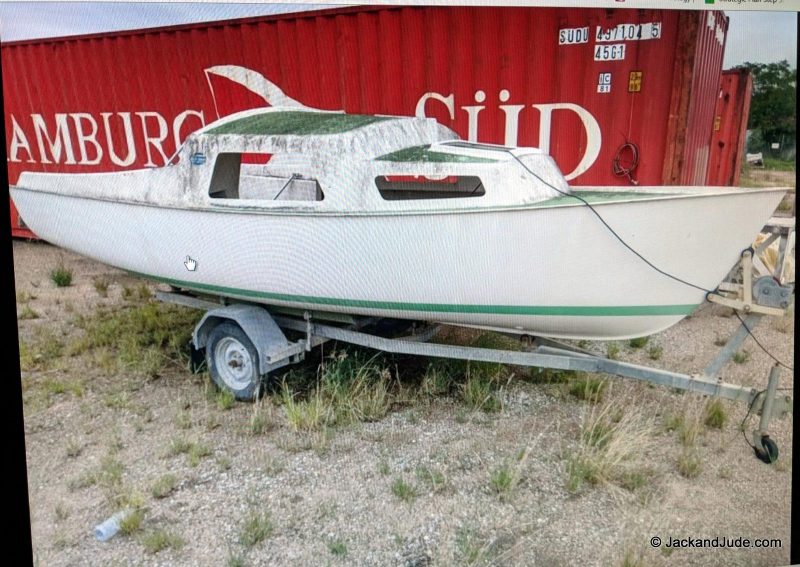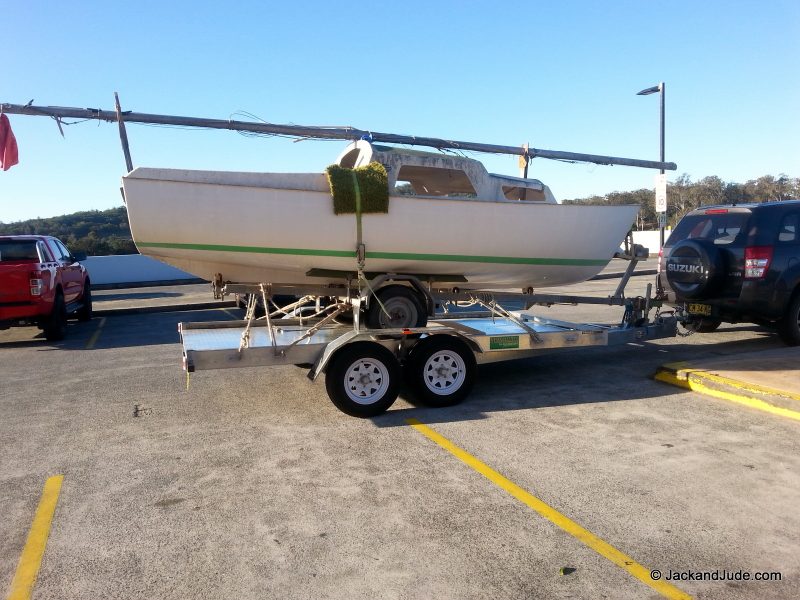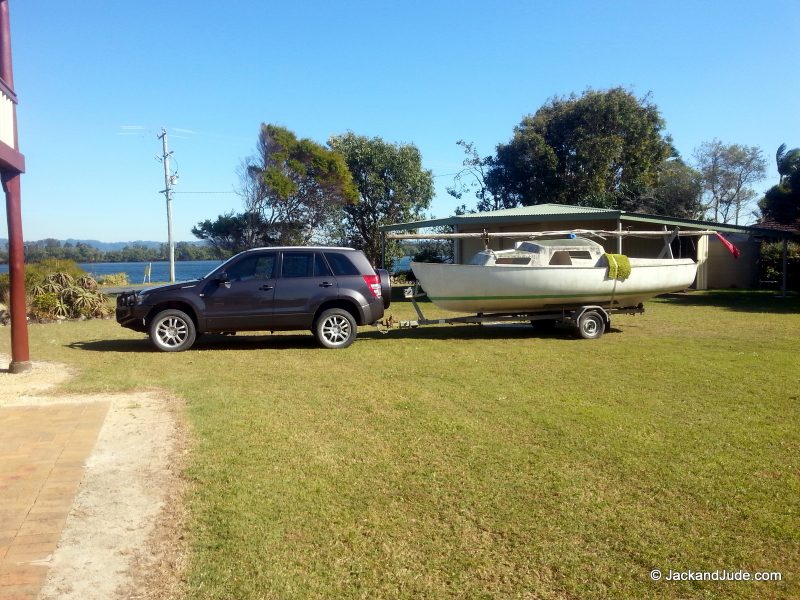Look what’s just landed on our front lawn
Well, we took the plunge last Sunday and bought a Careel 18′ Type 1, a project boat, from a most helpful and unforgettable man up in Brisbane. First task, getting her home. No mean feat considering we live 200 km away and the boat and trailer hadn’t moved in 7 years!

Waiting patently for a new home
Fortunately, even though we’re in our 70s (yiks – how’d that happen….) we’re pretty adept at achieving great things and had the foresight and courage to hire a car trailer and load her up. Scary that, but it went well. Then easy peasy, down the M1 at a even 100 kph, the ride as smooth as a baby’s bottom.

Up, up, and away down the highway


Mini-B has landed at her new home
These very popular craft were designed by John Duncanson and there were over 400 built in Sydney by David Rose Yachts with some built in Brisbane under licence. They’ve a lovely shape with a nice entry and flat bottom, made with hand laid up fibreglass. A simple rig and swing keel make them easy to rig and sail – a perfect craft to teach our grand kids how to sail.
Aah, but first comes the restoration!
Advice Required:
We could use a little help, of course. At this point a few photos of the retro fitted sliding hatch would help, one came with all the bits, but we’d like to see the hatch surround trims, and how they marry up with the companionway slides. Another task, the timber gunnel isn’t with the bits – any suggestions on a good stout remedy?
REPRINTED FROM BOATSALES CAREEL BUYERS GUIDE
The Careel trailer sailer success story involved selling complete sailing packages, not just boats, writes yacht broker David Bray in the second of his series on pre-loved yachts
Coffee, cake, the order book… And over 600 boats sold! “That’s how it happened,” says Pam Rose. “We’d take them for a sail, invite them back home for coffee and cake, and they’d buy a boat.”
I’ve known David and Pam Rose for many, many years, and they would have to be the most successful husband/wife team ever in the sailing industry! It’s 46 years, four children and over 600 boats since they met… and yet I still bump into them doing their weekly grocery shopping together.
When preparing my previous article on Compass Yachts (Trade-A-Boat January 2001), Don Lees mentioned that the Compass 18 moulds had been passed on to David and Pam, who he said were more suited to the ‘picnic and off-the-beach test sailing’ required of trailer yachts. History has proven Don to be an excellent judge!
STEP ASIDE, AL!
One evening at Woolworths, I asked David and Pam if they’d mind helping me with another article and got the happy reply: “Sure, come round to home and why not make it dinner?” So at the appointed time I turned up with a pad, a pen and an empty stomach for an evening of nonstop memories and good food. The music for the dinner was Al Jolson singing The Sun Shines East – The Sun Shines West (aka My Mammy).
Now Al’s a well-known worldwide performer, but he proved no match for the David, Pam and daughter Merinda act, as they recalled the Careel Yachts story!
Consequently I found myself sitting in the home office, wondering just where to start, having churned through an eight-inch pile of newsletters, magazines, journals and photos provided by the Roses from their archives.
Almost on cue, a bright yellow Careel 18 motored past, on its way to the Bayview launching ramp with its trusty Evinrude 7.5hp, giving away its age from around the early 1970s.
I then recalled David telling me: “We built them too well, they’re better than Rolls Royces!”
Now, direct from an owner of a 1956 Rolls Royce, that’s pretty strong stuff. But as David puts it: “Well, only 50% of the Rolls Royces built are still going around, and of the more than 600 Careels, we’ve lost less than a handful.”
Can you believe that David and Pam still keep a card on every boat built, and update it with every bit of input they get on new owners, etc, after 30 years!
A few have been lost: one Careel 22 was firebombed in the owner’s carport, so the keel was re-used in the replacement boat. One Careel 18 was run into on land by a furniture van, was poorly repaired and subsequently sunk during a Whitsunday cruise.
“They’ve even survived cyclones,” says David. Apparently Careel 18 No 65 lost all its gelcoat down one side during Cyclone Tracy (December 25, 1974). However, the boat was fully restored and was able to resume racing in Darwin and then take its owners cruising along the Queensland coast.
PJs INTO VJs
But we’re a little bit ahead of ourselves here… David started his sailing as a kid in VJs, progressing through Hartley TS16s to keelboats. He and Pam sailed a 30ft narrow-beamed timber yacht called Lady Luck out of the Sydney Amateur Sailing Club. “It cost us 750 pounds back then,” says David. “On one windy day we popped one of the crew in the bosun’s chair and hung him out the side, only to have the yachting association change the rules.”
That was in 1955, and David continued sailing happily and running the family electrical componentry business until a merchant navy penfriend wrote to him to say: “My mate John Duncanson has a beaut little boat, you should get down to Adelaide and become the Sydney agent.”
David was too busy running his business, as well as having a family of four kids. But ever the organiser, he sent one of his neighbours down who bought a boat. When David saw it, he decided to pick up the agency for the boat.
There was a brief amalgamation of interests between Duncanson Yachts and Compass Yachts, which complicated the agency arrangement David had just organised. However, the Duncanson/Compass deal fell apart and it wasn’t long before David had the agency back and decided that the boat could be improved and built better. (As an aside, it’s interesting that when the first Duncanson 18 was launched in Adelaide in June 1968, two TV stations were present to cover the big event – quite a contrast to the exposure given to yachting these days, apart from the maxi-yacht focus in the Sydney/Hobart coverage).
David readily admits that he knew nothing about fibreglass (not many people did in those days!) but he does pride himself on being able to get things done and have things put together correctly.
He located a boatbuilder, Ted Fitspatrick, who was building lightweight catamarans in Mona Vale just near the Griffin family’s shed. They set about producing a new set of moulds which incorporated many improvements, such as moulded fibreglass cockpit coamings, a foam-insulated icebox which was self-draining into the cockpit, a dedicated fueltank hatch, improved centreboard case with a cockpit controlled lowering and raising system and lock-down device, insulated cabin roof, and a completely finished interior.
SURREAL CAREEL
The first Compass Careel 18 (a kit boat) was produced on July 4, 1970, with the second boat displayed at the 1970 Sydney Boat Show. In the first boat test to be carried out by the yachting media, Paul Hopkins, Editor of Australian Seacraft, concluded: “The Careel is close to perfection. She’s a luxury liner compared with some sailing boats, which accounts for the price tag of around $4500, complete with outboard, trailer, toilet and 10 additional extras.”
The recipe was certainly successful, as the half-page ad in the same issue of Australian Seacraft boasted that 29 Careels had been sold in under 10 months. And all this while David held down his full-time job in the family business and Pam relaxed at home with only four kids… looking after the boat enquiries.
By this stage they were selling one boat a week, so the ritual was that David would set off after work on Thursday night and pick up a trailer, mast and set of sails so that Pam could go to the factory on Friday to pick up the completed boat for a weekend customer test sail and delivery. With Pam doing the quality control each Friday prior to handing over the cheque, no wonder the Careels had a reputation for quality and attention to detail!
Of course, the weekends were full of Careel Cruising Yacht Association of Australia events – cruises, races, picnics – plus inevitably the coffee, cake and cheque handover ritual.
Pam does recall that the most unusual deposit was received when she was standing on Sand Point at Palm Beach, serving as one end of the weekend racing’s finishing line with clipboard in hand, when a deposit cheque was thrust down the front of her swimsuit. That was Ross Feldberg buying the first of his two 18s and two Careel 22s, so Pam could afford a new swimsuit each year! Ross went on to become Commodore and Life Member of the Careel Association.
As time went on, David Rose kept making improvements to the 18. One of the first major changes was to replace the 65kg centreboard (which gave self-righting ability to 70?), with a heavier centreboard of 104kg. This was done from boat No 150 in 1974, although some of the older boats have been retro-fitted with the heavier keel.
Other improvements, such as the sliding hatch and anchor well, were added until the first Mark II (boat No 418) hit the water in 1981. Having worn out two sets of moulds, David decided to increase the freeboard of the third set by about 5cm to provide more interior space, as well as further improving the keel by increasing the weight to 186kg, while removing 45kg of internal lead ballast. This became the Careel 18 Mark III.
Never one to sit still, David again revised the deck moulding in 1985, raising the cabin for more headroom and making the cockpit more comfortable, with wider coamings and further modifications to the creature comforts down below, including an optional hydraulic keel winch. The first boat with these modifications was hull No 443.
LIVING IN THE ’70s
Backtracking now to the Careel 22… In 1973 David and Pam decided they needed a bigger boat for their family of six, particularly as the kids got bigger! So David approached Joe Adams, then of Helsalfame, to design the hull, with Hugh Treharne, then racing his Thomas Cameron 18ft skiff, as part of the ‘design committee’ with emphasis on sails and fittings.
Ken Beashel built the timber plug and John Buck (who became the builder of the Cole and Northshore yachts) made the moulds.
The ‘birthing’ of this new boat took longer than expected, due to a few Malcolm ‘life wasn’t meant to be easy’ Fraser pitfalls along the way.
When the first boat was launched, the Roses decided that the simple daggerboard-shaped swing keel didn’t provide enough lateral stability, so they designed the heavier boot-shaped keel for the production boats. As a consequence, the Careel 22 is renowned for its sailing abilities in strong winds, a bonus for those sailing short-handed or with family.
After 40 22s were built, the deck moulding was redesigned to allow for a bigger cabin, and thus a smaller but adequate cockpit.
The more spacious cabin was what David and Pam had originally envisaged, until the design committee got their way.
Sales picked up and a further 86 were built, proving the point that cruising boats sell, particularly if they’ve got the performance to class/club race.
AFTER THE GOLD RUSH
In 1990, the Roses purchased the Sonata 26 moulds from the liquidator and David, along with his band of friends, including Eric Rudd, set about ‘improving the breed’.
They concentrated on quality of build and ease of rigging and handling, including a one-person mast-raising system.
The first Careel Sonata 26 was launched in 1993, and it turned out to be a really beaut boat. However, the ’90s weren’t kind to builders of $50,000 trailer yachts. Even the Noelex 25, which was firmly entrenched as the leader of the pack in this field, hit the wall during that decade.
Consequently, having built one for a happy Victorian yachtie, David is still waiting for his second customer, but he does still enjoy sailing his own Careel Sonata 26 most weekends, and he produces lots of replacement rudders for both the Sonata 26 and Sonata 7.
Along the way, the Roses did a couple of boat shows in Europe with the Careel 18, and were even featured in general interest magazines such as Australian Home Journal (January 1973) and Vogue Living (October 1974). After all, trailer yachts were a craze back in the ’70s!
These days, new-boat sales may have died down to a trickle, but the Careel Association is still extremely strong – each month they publish a 20-page newsletter, have their own website (www.ccya.8m.com), a 115-page book of archives.
They also have an Australian Yachting Federation certified sailing school run by members qualified as instructors (for mums, dads and kids).
And of course David is more than happy to pick up the phone and answer any questions and give advice at any time. In fact, he prides himself on his card system of updated information for each boat, which has now stretched to three filing boxes!
The Roses have a traditional mid-December Christmas luncheon party for their association of friends. Pam was quite proud to mention that they had over 80 people last year. “Even though the kids have grown up, they still turn up and are really good friends,” she says.
So it seems David and Pam weren’t just selling fibreglass boats with aluminium masts, galvanised trailers and an outboard. They sold a complete sailing package that included the best and strongest class association.
Just about the only thing I can see has changed significantly is that the Careel Capers newsletter has changed to The Careel News… Perhaps a sign that the average membership age has increased slightly!
THE WONDER YEARS
After the Association’s 30th anniversary party last year, one of the members wrote to Pam and David, and in part said: “I’m sure you’re both extremely proud that your creation supports a vibrant and dynamic owners’ association 30 years on. The Careel wasn’t just another boat, but is in fact a lifestyle. This lifestyle combined a good, safe sailing boat with racing/cruising/social events and a strong owners’ association all with an emphasis on the family.
“For me, the Careel experience was a turning point in my lifetime. It provided new opportunities to meet new friends and families. It also provided new interests and needs as well as a great deal of fun. I often think about those times (I’m not sure if it’s escapism or hopeless romanticism), but without doubt they were the best times of my life. The kids that played in and around Currawong Avenue back then (after the weekend’s sailing) were given a wonderful experience in a safe family environment. I can still remember your street being lined with parked Careels on both sides. Your hospitality will long be remembered by all Careelers that you and your lovely family welcomed into your home – Thank you.”
Now we’ll give Pam the penultimate word (Al Jolson gave up long ago, well and truly beaten!). During the dinner Pam unblushingly and with a knowing smile said: “David would talk so much, people would buy a boat just to shut him up!”
Now Pam, if I could have the last word just this once… You and David are the perfect match, and please don’t change… Keep up the good work!
Current Market Values
(Depends on condition and inventory of the boat and trailer, and the age and condition of the motor)
Price Range
Approximate Towing Weights
|


Dougie Waters I have a Compass Career MK 1 and I am keen to see what you have done to instal the press button remote lifting keel.
I also wonder what sort of 2 way latch you have on the forward cockpit access point and where you may have acquired it I understand that it is mandatory to access from within and outside of the boat with such a lock
I live in the western suburbs of Brisbane Thanks Leigh
I have just done an inexpensive conversion on my Careel no #270 to press button remote for lifting keel .
For under $140 anyone interested happy to give you photos etc
Forsure Dougie, love to see what you’ve done. and a write up on how to do it. Cheers,
That is a perfect choice for teaching youngun’s to sail as they are a very forgiving sailboat that get’s along pretty well and is easy to rig. I also have one sitting on my back lawn! I can do the whole rig up, including stepping/unstepping the mast, single handed with no problems at all, I’m 65.
If you’re not sure about anything drop me a line and I can send you photo’s
P.S. mines the same horrible green, but beggars can’t be choosers.
Cheers Dave
Thanks Dave, she’s a beauty and far easier to handle than the RL24 we had. I’ll email you for some photos. Cheers Jack